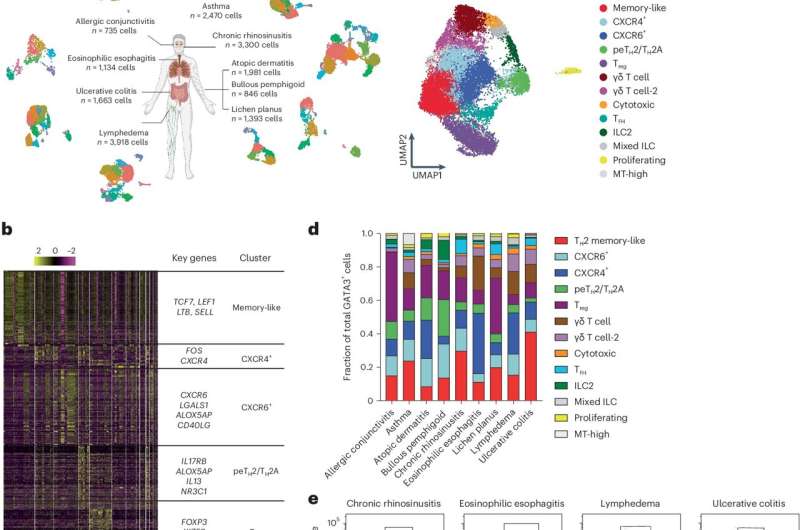
Currently, most therapies for allergic diseases require lifelong treatment. Allergic reactions, characterized by ongoing (type 2) inflammation in response to chronic antigen exposure, underlie many chronic diseases in humans, including asthma, atopic dermatitis, ulcerative colitis and more. T helper 2 (Th2) cells play an important role in the body’s immune response, particularly in allergic reactions. Despite their central role, the sustained activity of Th2 cells during allergic reactions, even in the face of constant antigen exposure, has long puzzled researchers.
A research team that included authors from Mass General Brigham, including members Brigham and Women’s Hospital, Massachusetts General Hospital, and Mass Eye and Ear, embarked on a quest to understand the diversity and cellular mechanisms of human Th2 cells. By conducting gene expression analyses of inflamed tissues, they pinpointed a subset of Th2 cells called Th2-MPP cells.
Their findings suggest that these cells might serve as precursors to several crucial Th2 cell populations responsible for disease symptoms. These discoveries lay the groundwork for therapeutic interventions targeting these cells, potentially offering relief to patients living with allergic diseases. Results are published in Nature Immunology.
The research team created a single cell transcriptomic atlas, a comprehensive database of genes that are turned “on” and “off” in individual cells in the body, using inflamed tissues from patients with nine different chronic allergic diseases. They used this atlas to identify Th2-multipotent progenitor (Th2-MPP) cells, which chronically expressed two transcription factors, TCF7 and LEF1. These transcription factors allowed Th2-MPP cells to exhibit characteristics similar to stem cells in cancer and chronic infection, acting as progenitor cells that can give rise to other kinds of cells.
The team also performed detailed studies on Th2 cells from nasal tissue in patients with chronic rhinosinusitis. They found that Th2-MPP cells could be the precursor for multiple types of Th2 cells that cause disease symptoms.
“We still have much to learn about the contribution of progenitor cells to chronic human inflammation, but we are hopeful that the study of this area of immunity could provide opportunities for future disease-modifying therapeutic approaches,” said senior author Patrick Brennan, MD, Ph.D., a physician-researcher in the Brigham Division of Allergy and Clinical Immunology.
“Our work suggests that Th2-MPP cells have the potential to sustain type 2 inflammation in the face of chronic antigen exposure and lays the foundation for further investigation to better understand their contribution to disease,” said lead author Radomir Kratchmarov, MD, a research fellow in the Brigham Division of Allergy and Clinical Immunology.
More information:
Radomir Kratchmarov et al, TCF1–LEF1 co-expression identifies a multipotent progenitor cell (TH2-MPP) across human allergic diseases, Nature Immunology (2024). DOI: 10.1038/s41590-024-01803-2
Citation:
Gene expression analyses identify potential drivers of chronic allergic inflammation (2024, April 30)
gene-analyses-potential-drivers-chronic.html
.
. The content is provided for information purposes only.
